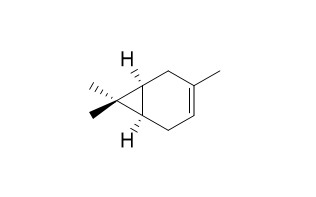(+)-D-3-Carene
Reference standards.
Inquire / Order:
manager@chemfaces.com
Technical Inquiries:
service@chemfaces.com
Tel:
+86-27-84237783
Fax:
+86-27-84254680
Address:
1 Building, No. 83, CheCheng Rd., Wuhan Economic and Technological Development Zone, Wuhan, Hubei 430056, PRC
Providing storage is as stated on the product vial and the vial is kept tightly sealed, the product can be stored for up to
24 months(2-8C).
Wherever possible, you should prepare and use solutions on the same day. However, if you need to make up stock solutions in advance, we recommend that you store the solution as aliquots in tightly sealed vials at -20C. Generally, these will be useable for up to two weeks. Before use, and prior to opening the vial we recommend that you allow your product to equilibrate to room temperature for at least 1 hour.
Need more advice on solubility, usage and handling? Please email to: service@chemfaces.com
The packaging of the product may have turned upside down during transportation, resulting in the natural compounds adhering to the neck or cap of the vial. take the vial out of its packaging and gently shake to let the compounds fall to the bottom of the vial. for liquid products, centrifuge at 200-500 RPM to gather the liquid at the bottom of the vial. try to avoid loss or contamination during handling.
Asian J Beauty Cosmetol2020, 18(3): 265-272.
Appl. Sci.2021, 11(24),12080
Int J Mol Med.2020, 45(5):1514-1524.
Cells.2021, 10(10):2633.
Expert Opin Ther Targets.2024, :1-11.
Food Hydrocolloids2024, 156:110345
Pharmaceutics.2021, 13(7):1028.
Phytother Res.2019, 33(5):1490-1500
Life Sci.2021, 270:119074.
Arch Biochem Biophys.2018, 644:93-99
Related and Featured Products
Braz. J. Microbiol. 2006,37(4).
Essential oil of Lithraea molleoides (Vell.): chemical composition and antimicrobial activity。[Reference:
WebLink]
Lithraea molleoides (Vell.) (Anacardiaceae) is a tree found in Brazil, Paraguay, Bolivia, Uruguay, Argentina and Chile. It is popularly used in the form of alcoholic extracts, decoctions and infusions for the treatment of cough, bronchitis, arthritis, diseases of the digestive system and as diuretic, tranquilizer, haemostatic and tonic agent.
METHODS AND RESULTS:
The objectives of this study were the extraction of the essential oil of the mature fruit, leaves and aerial parts of the plant and quantification of the yield thereof; the identification and quantification of the principal components of the essential oil and the determination of its antimicrobial activity against bacteria and yeast. The essential oil yield of the mature fruits was 1.0% but essential oil was not detected in leaves and flowery branches. The gas chromatograph-mass spectrometer (GC-MS) analysis of the essential oil of the mature fruits detected the presence of limonene (89.89%), a-pinene (3.48%), b-pinene (2.63%), a-terpineol (1.27%), myrcene (0.64%), sabinene hydrate (0.54%), 4-terpineol (0.28%), camphene (0.22%) and
D-3-carene ((+)-D-3-Carene,0.13%).
CONCLUSIONS:
The essential oil was active against just a few of the Gram-positive bacteria and yeast tested and did not present antimicrobial activity against Gram-negative bacteria.



